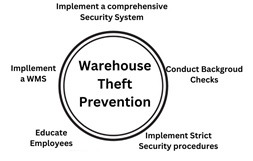
Warehouse Theft: Strategies to Prevent and Mitigate Losses
Warehouse theft is a serious problem that can cost businesses millions of dollars each year. Whether you are a small distributor or a large logistics company, the potential for theft within your warehouse poses a significant threat to your bottom line and operational efficiency. In this article, I explore the various aspects of warehouse theft, its impact on businesses, and effective strategies to prevent and mitigate losses.
Types of warehouse theft
There are many reasons why theft occurs in warehouses, but some of the most common include:
- Employee theft: This is the most common type of theft and can be committed by current and former employees. Employee theft can be motivated by financial hardship, revenge, or simply the opportunity to steal. In fact, a study by the University of North Florida found that employee theft is more likely to occur in warehouses with high employee turnover and low employee morale.
- Organized crime: Organized crime groups often target warehouses because they know that they can steal large quantities of valuable goods without being detected.
- Opportunistic theft: Opportunistic theft occurs when someone sees an opportunity to steal something from a warehouse and takes it. This could be a truck driver, a delivery person, or even a visitor to the warehouse.
- Lack of control: It can be easy for employees to steal goods without being detected when there is no clear system of accountability and employees have too much freedom of movement
Impact on businesses
Warehouse theft can have a significant impact on businesses at both, financially and operationally. Here are some of the most important consequences:
Financial losses: The most direct impact of theft is the financial loss of the stolen inventory, which can be a significant blow to a business, especially if high-value items are stolen.
Increased insurance premiums: After a theft, businesses may have to pay higher insurance premiums because insurance companies view businesses that have experienced theft as a higher risk.
Damage to reputation: Customers may be less likely to do business with a company that has experienced theft, leading to lost sales and revenue.
Disruption of supply chain operations: Inventory theft can disrupt a company’s supply chain operations (as mentioned in a recent article). If stolen inventory is not replaced quickly, it can lead to delays in fulfilling customer orders..
Preventing Warehouse Theft
There are a number of things that businesses can do to prevent inventory theft, including:

LaceUp Solutions WMS software includes the features that allow detection of inventory deviations. If you want to know how Laceup’s solutions can help you with inventory optimizations, click the link below to schedule an exploratory meeting.
I hope this article has been helpful to you. I will continue to post information related to warehouse management, distribution practices and trends, and the economy in general.
There is a lot of relevant information on our channel. Check this video on Chow a customer lost $300K EVERY YEAR in Warehouse Theft.


Sorry, the comment form is closed at this time.